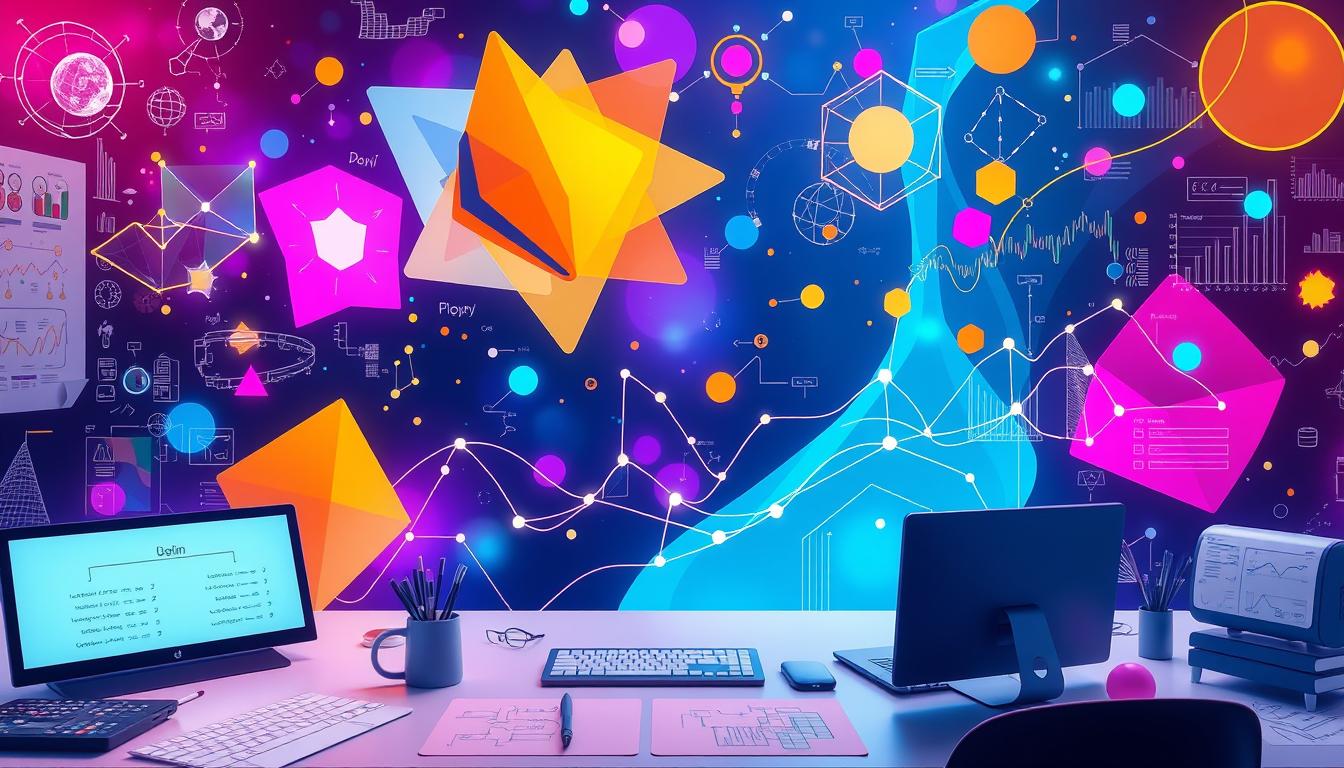The global machine learning market hit $15.44 billion in 2021. It’s expected to soar to $209.91 billion by 20291. The AI market is also booming, aiming to reach $500 billion by 2023 and $1,597.1 billion by 20302.
This rapid growth is reshaping business strategies. Companies using AI can cut costs by up to 30%. AI is also set to boost the global economy by $15.7 trillion by 20302.
Algorithmic Thinking, Algorithm Design, and Computational Thinking are becoming key. They help businesses use machine learning to innovate, make better decisions, and run smoother operations. This change is happening in all sectors, from manufacturing to retail, and even in bakeries1.
Key Takeaways
- Algorithmic Thinking is transforming business strategy, with machine learning driving innovation and efficiency
- The global machine learning market is projected to skyrocket, reaching over $200 billion by 2029
- AI integration can reduce operational costs by up to 30% and add trillions to the global economy
- Supervised, unsupervised, and reinforcement machine learning models are revolutionizing industries
- Neural networks and deep learning are enabling machines to mimic the human brain and process vast amounts of data
Understanding AI and Machine Learning Evolution in Business
Artificial intelligence (AI) and machine learning (ML) have changed how businesses work. They use computer vision and natural language processing to improve operations. These technologies are making a big difference.
Machine learning algorithms are at the heart of this change. They help with predictive analytics and customer segmentation. This leads to better decision-making and efficiency in various industries.
Foundations of Modern AI Technology
The journey of AI and ML started long ago. It picked up speed with the advent of personal computers and the internet. Now, these technologies are changing how businesses use data and make decisions.
Key Components of Machine Learning Systems
Today’s machine learning systems handle huge amounts of data from IoT devices. They make decisions in real-time. Deep learning and neural networks help analyze complex data to find valuable insights.
The Role of Big Data in AI Development
Big data has been key to the AI and ML revolution. It helps businesses use predictive maintenance. This reduces downtime and costs. AI tools are now more accessible, encouraging innovation in many fields.
As AI and ML keep evolving, businesses need to keep up. They should understand the latest in algorithm analysis and problem-solving. This way, they can use AI to improve their operations and succeed in the long run.
The Market Impact and Growth of AI Technologies
Artificial intelligence (AI) and machine learning are changing the global market. The machine learning platforms market is expected to hit $31.36 billion by 20283. More companies are using AI to improve customer experience, with 57% doing so3.
But, there’s a big gap in talent. Only 12% of companies have enough skilled people, while 82% need them3.
AI adoption is speeding up. By 2024, 77% of companies will use or explore AI, and 83% see it as a key business goal4. AI could add $15.7 trillion to the global economy by 20304.
AI might cut 85 million jobs but create 97 million new ones by 2025. This could lead to a net gain of 12 million jobs4.
Different groups have varying levels of AI awareness and use4. Asians, men, and those aged 30-49 are most aware of AI4. Virtual assistants like Siri and Alexa are the most used AI technology weekly4.
AI’s impact is vast, touching finance, national security, healthcare, and more5. As the market grows, businesses must keep up with AI trends to stay ahead345.
Algorithmic Thinking, Algorithmic Thinking Concepts, Algorithmic Thinking Trends
Algorithmic reasoning and optimization are key to AI and machine learning in business. Computational thinking is at the heart of solving problems with algorithms. It includes breaking down complex issues, spotting patterns, and creating repeatable solutions6.
Core Principles of Algorithmic Decision Making
Algorithmic thinking is about making systematic, logical steps to find solutions. It’s seen in long division, computer tests, and Google’s PageRank algorithm6. Design thinking, which also solves problems, involves empathy and creating prototypes6.
Implementation Strategies for Business
Using algorithmic and design thinking is vital for data science projects. Today, tasks that took days or hours are expected to be done in minutes or seconds7. Also, making computation efficient is key for sustainable solutions in IoT and edge computing7.
Future Trends in Algorithmic Solutions
Data scientists must think about how to make algorithms efficient and scalable. The diversity of data science professionals also highlights the need for good algorithmic thinking training7.
“Algorithmic thinking is the core of computational thinking and is essential for effective problem-solving in the digital age.”
As businesses use more AI and machine learning, knowing how to reason and optimize algorithms will be key. It will shape the future of business strategy and efficiency.
Transforming Business Operations Through AI
AI is changing how businesses work. Companies can now meet customer needs 50% faster8. They also see a 31% cost drop in three years8. By 2025, AI could make labor 37% more productive8.
AI is great at handling big data and finding hidden patterns. Deep learning models, like Convolutional Neural Networks, learn from lots of data. This helps them analyze images for self-driving cars8. This skill lets companies make better decisions, leading to big improvements in how they work.
The future of AI in business looks bright. AI is becoming a key tool in many areas, like security and customer service9. As AI gets better with more data, businesses will see more benefits. They’ll get better at automating tasks, serving customers, and making decisions9.
| AI-Powered Business Transformation | Impact |
|---|---|
| Faster response to customers and competitors | 50% increase8 |
| Average cost reduction within 3 years | 31%8 |
| Labor productivity increase by 2025 | 37%8 |
“AI is transforming business operations, enabling companies to respond faster, reduce costs, and boost productivity. The integration of Algorithmic Thinking and Algorithm Visualization is key to unlocking the full technological revolution.”
Machine Learning Applications in Different Industries
Machine learning is changing many industries. It’s making healthcare, finance, manufacturing, and supply chain management better. This technology is making big changes everywhere.
Healthcare and Medical Diagnostics
In healthcare, machine learning is changing how doctors diagnose. It uses special computer models to recognize images over 99% accurately. This means doctors can make quicker and more accurate diagnoses.
It also helps in patient communication. Chatbots use machine learning to talk to patients, making communication better. This is thanks to advanced computer models that learn from data.
Financial Services and Banking
In finance, machine learning is changing banking. It uses models to predict what will happen in the future. This helps banks make better decisions.
It also helps keep customer data safe. Advanced computer models can spot fraud and protect customers’ information. This makes banking safer for everyone.
Manufacturing and Supply Chain
Manufacturing and supply chain have also seen big changes. Machine learning helps predict what will happen next. This makes planning and production faster and more accurate.
It also makes data easier to handle. By simplifying data, machines can process it faster. This makes businesses more efficient.
As more industries use machine learning, things will keep getting better. It’s making businesses smarter and more efficient. This is changing the way we work and live.
“Machine learning is the future, not only for research but in our daily lives. It is a field that has so much to offer.” – Fei-Fei Li, Professor of Computer Science at Stanford University
The Economic Impact of AI Integration
Artificial Intelligence (AI) and machine learning are set to change the world’s economy. Accenture says AI could add $14 trillion to the global economy by 2035. This growth is expected to be big in China and North America10.
In healthcare, AI has already cut sepsis deaths by 20% in hospitals. This shows how powerful AI can be10.
A McKinsey & Company report says AI can automate up to 45% of tasks in retail, hospitality, and healthcare10. But, a World Economic Forum study finds AI could also create more jobs, mainly in fields needing more education and skills10. AI in finance could also boost global GDP by 7%, or nearly $7 trillion, by making things more productive10.
| Industry | Estimated AI Impact |
|---|---|
| Healthcare | 20% reduction in sepsis deaths10 |
| Retail, Hospitality, Healthcare | Up to 45% of tasks automated10 |
| Finance | Increase in global GDP by 7% ($7 trillion)10 |
AI’s economic benefits are clear, but there are also challenges. The World Economic Forum says there could be a shortage of 10 million healthcare workers by 2030. AI could help by making things more efficient10. But, a McKinsey & Company study warns AI might also lead to job losses, with benefits not evenly spread10.
The impact of AI on the economy is complex. As AI evolves, it’s key for everyone to work together. Policymakers, businesses, and society must ensure AI’s benefits are shared fairly and risks are managed1112.

Challenges and Considerations in AI Implementation
Businesses are diving into artificial intelligence (AI) and algorithmic reasoning. But, they face many challenges and considerations. One big worry is security and privacy. With more AI use, data breaches and cyberattacks are on the rise13.
Experts say strong security, good data management, and following rules are key. These steps help keep sensitive info safe.
Another big issue is the resource requirements and investment for AI. It takes a lot of money and skilled people to set up and keep AI systems running14. The lack of AI experts and the need for more training make things tough for companies.
Training and Skill Development
Teaching the workforce about AI is vital. As more jobs need AI skills, schools and companies must offer good training14. Adding AI and computational thinking to education and training can help fill the skill gap.
To succeed with AI, companies need to tackle security, resources, and training. By doing this, they can use AI to improve their business and stay competitive15.
| Challenge | Description |
|---|---|
| Security and Privacy Concerns | Risks of data breaches and cyberattacks require robust security measures, data governance, and regulatory compliance. |
| Resource Requirements and Investment | Substantial financial resources and availability of skilled personnel are needed to develop, deploy, and maintain AI systems. |
| Training and Skill Development | The shortage of AI and algorithmic experts necessitates extensive training programs to equip the workforce with the necessary skills. |
“The principles of algorithmic thinking are increasingly valuable in interdisciplinary applications such as healthcare, finance, and complex societal issues.”
Building a Future-Ready AI Strategy
Businesses are now focusing more on Algorithm Optimization and Algorithmic Thinking to stay ahead. Studies show 59% of companies are investing in AI for this reason16. A good AI strategy includes making experiences better, solutions bigger, and systems easier to use.
It’s important to balance AI with human oversight. AI can make things faster and more efficient. But, humans are needed to make sure decisions are right and users trust the system1617. This balance helps businesses grow and innovate.
- Learn about Algorithmic Thinking like breaking down problems and finding patterns16.
- Use Algorithm Optimization to make better decisions with data16.
- Keep learning and growing, so everyone can keep up with AI and tech17.
- Make sure AI is safe and ethical, protecting its integrity17.
By using Algorithm Optimization and Algorithmic Thinking, companies can create a strong AI strategy. This strategy helps them grow, improve customer experiences, and succeed in the digital world.
| Key Computational Thinking Concepts | Benefits to Students |
|---|---|
| Decomposition | Breaks down complex problems into manageable parts |
| Pattern Recognition | Identifies commonalities and makes predictions |
| Abstraction | Focuses on relevant information, ignoring extraneous details |
| Algorithmic Thinking | Develops sequential rules to solve problems effectively |
“Computational thinking paves the way for future success, both professionally and in everyday life.”
Measuring ROI and Success Metrics in AI Projects
More companies are using algorithm visualization and computational thinking to boost their AI efforts. Studies show that 42% of businesses say their AI projects have made more money than expected18. They see big wins in cutting costs, boosting productivity, and making customers happier18.
When it comes to AI, measuring ROI is all about numbers and feelings19. Numbers show how much money is saved, how much more is made, and how work gets done better. But feelings matter too, like how AI changes decisions, makes employees happy, and shapes the company19.
To know if AI is working, companies pick KPIs that match their goals18. This helps them see if AI is really making a difference.
Creating POCs is a smart way to test AI ideas before going big19. It helps figure out if AI will pay off and if it’s worth the risk. AI projects can be pricey, so knowing all the costs is key to understanding the ROI1819.
By linking AI to clear goals and keeping an eye on how it’s doing, companies can get the most out of AI. This way, they can make sure their AI investments are worth it.
FAQ
What is the current state of the global machine learning market?
FAQ
What is the current state of the global machine learning market?
The global machine learning market hit .44 billion in 2021. It’s expected to reach 9.91 billion by 2029. The AI market is set to grow to 0 billion by 2023 and
FAQ
What is the current state of the global machine learning market?
The global machine learning market hit $15.44 billion in 2021. It’s expected to reach $209.91 billion by 2029. The AI market is set to grow to $500 billion by 2023 and $1,597.1 billion by 2030.
How can AI and machine learning benefit businesses?
Companies using AI can cut operational costs by up to 30%. AI is expected to add $15.7 trillion to the global economy by 2030. Machine learning systems analyze IoT data for real-time decisions.
Big data integration helps with predictive maintenance. This reduces downtime and cuts costs.
What is the current state of the machine learning platforms market?
The machine learning platforms market is set to hit $31.36 billion by 2028. 57% of organizations focus on AI for customer experience. Yet, 82% need machine learning skills, but only 12% have enough.
How are machine learning algorithms being used in business?
ML algorithms are very good at recognizing patterns and making decisions. 49% of companies use ML for finding new customers. 48% use it for gaining customer insights.
Future trends show more automation and integration in business processes.
What are the benefits of AI-powered enterprises?
AI-powered companies respond 50% faster to customers and competitors. Intelligent automation can cut costs by 31% in three years. By 2025, ML and AI will increase labor productivity by 37%.
How is AI being adopted in different industries?
The healthcare AI market is valued at $11.06 billion in 2021. It’s expected to reach $187.95 billion by 2030. The banking AI market is set to hit $15.32 billion by 2028.
The manufacturing AI market is projected to grow from $2.3 billion to $16.3 billion by 2027.
What is the economic impact of AI integration?
AI could increase global GDP by 14% ($15.7 trillion) by 2030. US AI spending is expected to reach $120 billion by 2025. 91% of top businesses are investing in AI.
What are the common challenges in AI implementation?
50% of AI projects fail due to skill shortages, high costs, and data management. Security automation is key for cybersecurity. There are concerns about data breach costs and automation levels.
How are organizations approaching AI investments and implementation?
59% of companies focus on AI for future-proofing. They aim for customizable experiences, scalable solutions, and integration with existing systems. Success requires balancing automation with human oversight.
How are organizations measuring the success of their AI initiatives?
42% of companies say their AI projects are more profitable than expected. Success is measured by cost reduction (up to 30%), productivity gains, and improved customer satisfaction. ROI focuses on both numbers and quality.
,597.1 billion by 2030.
How can AI and machine learning benefit businesses?
Companies using AI can cut operational costs by up to 30%. AI is expected to add .7 trillion to the global economy by 2030. Machine learning systems analyze IoT data for real-time decisions.
Big data integration helps with predictive maintenance. This reduces downtime and cuts costs.
What is the current state of the machine learning platforms market?
The machine learning platforms market is set to hit .36 billion by 2028. 57% of organizations focus on AI for customer experience. Yet, 82% need machine learning skills, but only 12% have enough.
How are machine learning algorithms being used in business?
ML algorithms are very good at recognizing patterns and making decisions. 49% of companies use ML for finding new customers. 48% use it for gaining customer insights.
Future trends show more automation and integration in business processes.
What are the benefits of AI-powered enterprises?
AI-powered companies respond 50% faster to customers and competitors. Intelligent automation can cut costs by 31% in three years. By 2025, ML and AI will increase labor productivity by 37%.
How is AI being adopted in different industries?
The healthcare AI market is valued at .06 billion in 2021. It’s expected to reach 7.95 billion by 2030. The banking AI market is set to hit .32 billion by 2028.
The manufacturing AI market is projected to grow from .3 billion to .3 billion by 2027.
What is the economic impact of AI integration?
AI could increase global GDP by 14% (.7 trillion) by 2030. US AI spending is expected to reach 0 billion by 2025. 91% of top businesses are investing in AI.
What are the common challenges in AI implementation?
50% of AI projects fail due to skill shortages, high costs, and data management. Security automation is key for cybersecurity. There are concerns about data breach costs and automation levels.
How are organizations approaching AI investments and implementation?
59% of companies focus on AI for future-proofing. They aim for customizable experiences, scalable solutions, and integration with existing systems. Success requires balancing automation with human oversight.
How are organizations measuring the success of their AI initiatives?
42% of companies say their AI projects are more profitable than expected. Success is measured by cost reduction (up to 30%), productivity gains, and improved customer satisfaction. ROI focuses on both numbers and quality.
How can AI and machine learning benefit businesses?
What is the current state of the machine learning platforms market?
How are machine learning algorithms being used in business?
What are the benefits of AI-powered enterprises?
How is AI being adopted in different industries?
What is the economic impact of AI integration?
What are the common challenges in AI implementation?
How are organizations approaching AI investments and implementation?
How are organizations measuring the success of their AI initiatives?
Source Links
- Machine learning, explained | MIT Sloan – https://mitsloan.mit.edu/ideas-made-to-matter/machine-learning-explained
- Artificial Intelligence for Business | Berkeley Exec Ed Online Program – https://em-executive.berkeley.edu/artificial-intelligence-business-strategies
- What’s the Future of AI in Business? – Professional & Executive Development | Harvard DCE – https://professional.dce.harvard.edu/blog/whats-the-future-of-ai-in-business/
- 131 AI Statistics and Trends for (2024) | National University – https://www.nu.edu/blog/ai-statistics-trends/
- How artificial intelligence is transforming the world – https://www.brookings.edu/articles/how-artificial-intelligence-is-transforming-the-world/
- Definitions of Computational Thinking, Algorithmic Thinking & Design Thinking – https://www.learning.com/blog/defining-computational-algorithmic-design-thinking/
- Algorithmic Thinking for Data Scientists – https://towardsdatascience.com/algorithmic-thinking-for-data-scientists-4601ac68496f
- How Artificial Intelligence Is Transforming the Business World? – https://pcsocial.medium.com/how-artificial-intelligence-is-transforming-the-business-world-a216a0b70a67
- How Artificial Intelligence Is Transforming Business – businessnewsdaily.com – https://www.businessnewsdaily.com/9402-artificial-intelligence-business-trends.html
- Generative AI and Its Economic Impact: What You Need to Know – https://www.investopedia.com/economic-impact-of-generative-ai-7976252
- PDF – https://www.whitehouse.gov/wp-content/uploads/2022/12/TTC-EC-CEA-AI-Report-12052022-1.pdf
- No title found – https://www.elibrary.imf.org/view/journals/001/2024/065/article-A001-en.xml
- Do We Still Need to Learn Algorithmic Thinking and Problem Solving in the Age of AI? – – https://algocademy.com/blog/do-we-still-need-to-learn-algorithmic-thinking-and-problem-solving-in-the-age-of-ai/
- The Challenges and Rewards of Integrating Computational Thinking Skills into the Curriculum – https://www.linkedin.com/pulse/challenges-rewards-integrating-computational-thinking-x9e7c
- Algorithmic Management in Organizations: Benefits, Challenges, and Best Practices – https://www.aihr.com/blog/algorithmic-management/
- Early Learning Strategies for Developing Computational Thinking Skills – https://www.gettingsmart.com/2018/03/18/early-learning-strategies-for-developing-computational-thinking-skills/
- Building Computational Literacy Through STEM Education – https://www.whitehouse.gov/wp-content/uploads/2023/11/Building-Computational-Literacy-Through-STEM-Ed-Guide-for-Federal-Agencies-FINAL-PUBLIC.pdf
- How to Measure (and Increase) the ROI of AI Initiatives – https://www.pecan.ai/blog/how-to-measure-increase-roi-of-ai/
- How to Estimate ROI for AI and ML Projects – https://www.phdata.io/blog/how-to-estimate-roi-for-ai-ml-projects/










